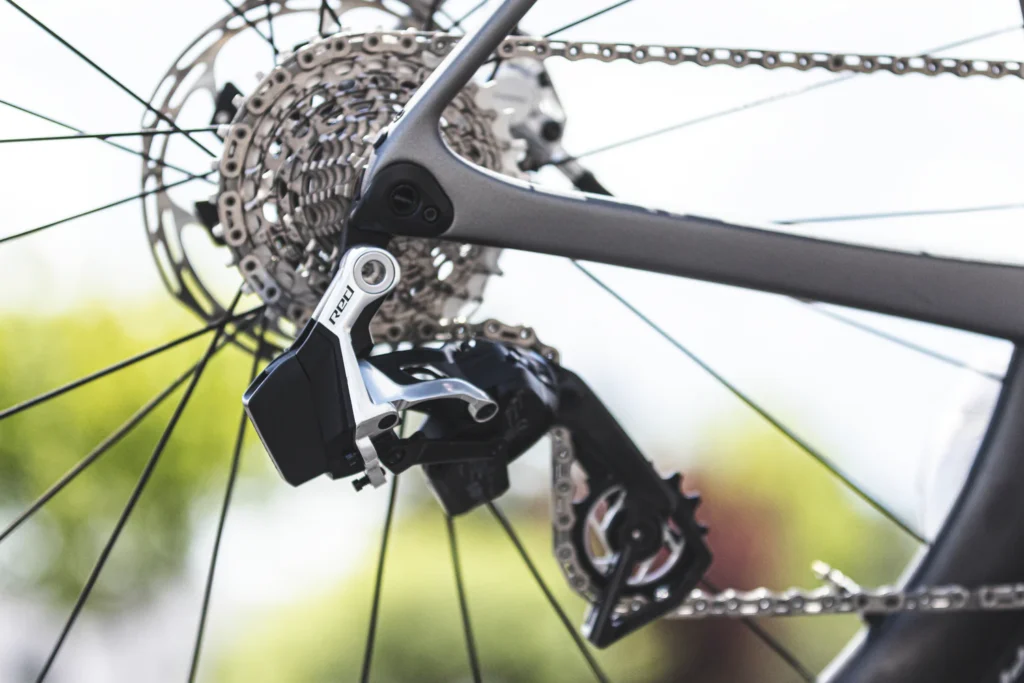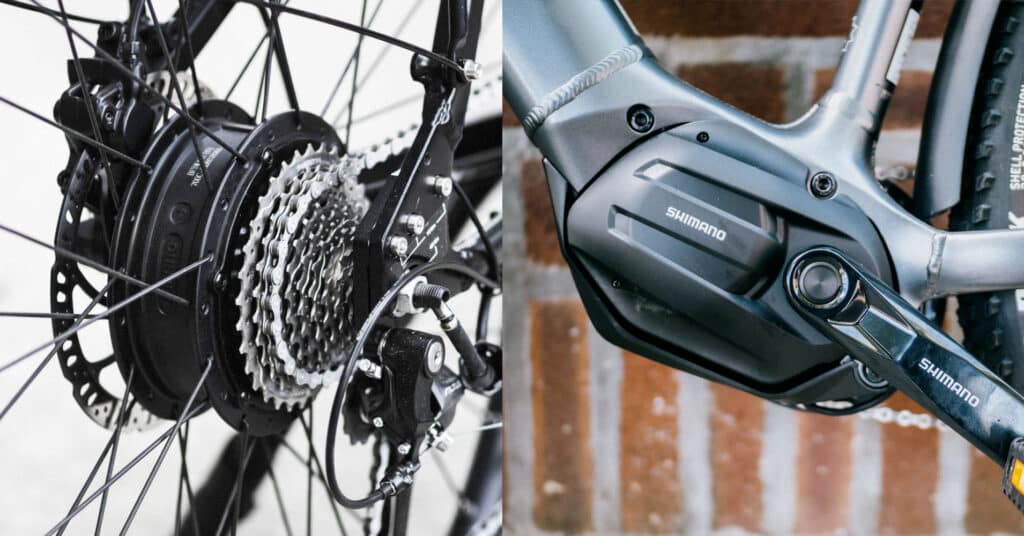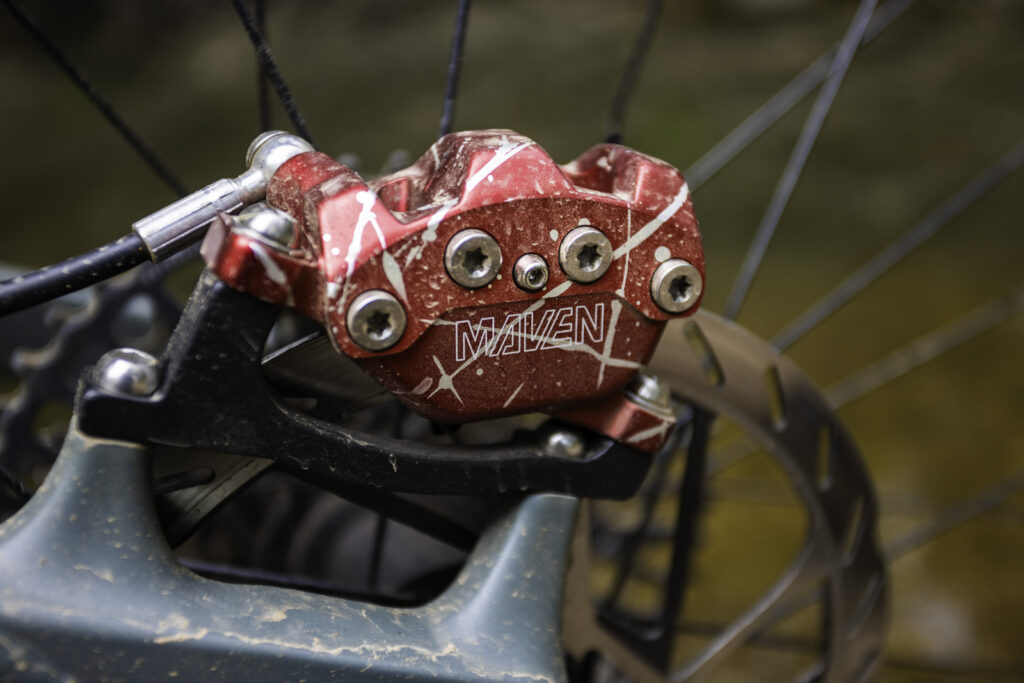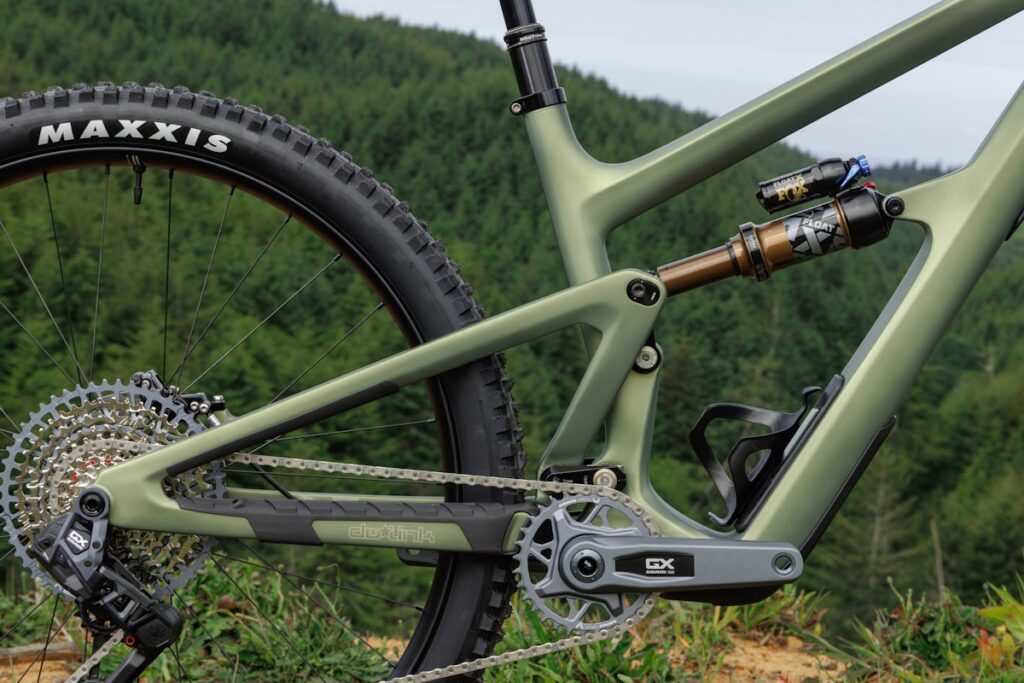When it comes to bicycle drivetrains, no rivalry defines modern cycling more than Shimano vs SRAM.
For decades, these two giants have gone toe-to-toe — each pushing the other to refine, reinvent, and redefine what’s possible on two wheels.
Whether you’re a performance road racer, gravel adventurer, or mountain bike purist, your bike’s personality — how it shifts, feels, and even sounds — is shaped by the name on your derailleur.
In this deep comparison, we break down the 2026 product lineups, shifting systems, braking tech, and long-term ride experience from both Shimano and SRAM.
This isn’t a simple “which is better” article — it’s an honest look at two philosophies of performance that shape every turn of your cranks.
Quick Take
- Shimano = Refined precision, quiet reliability, subtle evolution.
- SRAM = Bold innovation, wireless simplicity, mechanical edge.
Both are world-class — but they excel in different ways.
Let’s dive into the details that define them.
Brand Overview
Shimano
Founded in 1921 in Osaka, Japan, Shimano built its empire on the principles of precision engineering and kaizen — continuous improvement.
Its dominance comes from decades of careful refinement, reliability, and a “fit and forget” approach that appeals to everyone from commuters to pros.
- Core strengths: Smoothness, durability, global service network.
- Best known for: Di2 electronic shifting, Hyperglide+, and bulletproof hydraulic brakes.
- Brands owned: PRO Components, Lazer helmets, Pearl Izumi (historic).
SRAM
Founded in 1987 in Chicago, SRAM grew fast through innovation and bold risk-taking.
From the original Grip Shift to today’s AXS wireless ecosystem, the company’s goal has always been simplicity and performance through technology.
- Core strengths: Innovation, clean wireless systems, and aggressive product design.
- Best known for: 1x drivetrains, AXS wireless shifting, Eagle Transmission.
- Brands owned: RockShox, Zipp, Truvativ, Quarq.
Technology Overview
| Technology | Shimano | SRAM |
|---|---|---|
| Electronic Shifting | Di2 (semi-wireless) | AXS (fully wireless) |
| Mechanical Shifting | 11–12 speed | 10–12 speed |
| Brake Fluid | Mineral oil | DOT fluid |
| Drivetrain Design | 2x focus with front mech integration | 1x focus (no front mech) |
| Chain Tech | Hyperglide+, LinkGlide | X-Sync, T-Type |
| Crank Interface | Hollowtech II | DUB |
| App Integration | E-Tube Project | SRAM AXS App |
| Ecosystem Integration | Di2 + Steps (e-bikes) | AXS + RockShox + Zipp |
Drivetrain Philosophy
Shimano: The Smooth Operator
Shimano’s drivetrains focus on fluid, consistent power transfer. Every shift feels subtle — more glide than click.
The company prioritizes balance, ergonomics, and silence. You rarely notice it working — and that’s the point.
Key traits:
- 2x gearing still preferred for cadence control.
- Semi-wireless Di2 ensures reliability via a shared central battery.
- Shift ramps (Hyperglide+) allow seamless transitions under load.
SRAM: The Bold Simplifier
SRAM thrives on eliminating complexity. It made front derailleurs obsolete for most bikes and reimagined shifting with full wireless.
The result is a cleaner cockpit, fewer parts, and a tactile, digital feel.
Key traits:
- 1x drivetrain simplicity for road, gravel, and MTB.
- Full wireless (AXS) with customizable shift mapping.
- Fast, crisp, mechanical-like digital response.
Electronic Shifting: Di2 vs AXS
Shimano Di2
- Connection: Semi-wireless (wireless levers, wired derailleurs).
- Power: One shared battery (lasts 1,000–1,500 miles).
- Customization: E-Tube app (shift logic, button assignment).
- Shift feel: Ultra-smooth, nearly silent.
- Reliability: Proven — used in the pro peloton since 2009.
Di2 2026 Upgrades:
- Instant wake mode.
- Wireless range increased by 30%.
- GRX Di2 12-speed for gravel now matches road performance.
SRAM AXS
- Connection: Fully wireless (each derailleur has its own battery).
- Power: 20–60 hours per charge per battery.
- Customization: AXS app (full button mapping, cross-device pairing).
- Shift feel: Instant, audible “click,” more mechanical in feedback.
- Reliability: Excellent; waterproof and field-proven.
AXS 2026 Upgrades:
- Extended battery life by 15%.
- Improved clutch engagement for Eagle Transmission.
- New AXS Pods for ergonomic customization.
Verdict: Electronic Shifting
- Shimano: Wins on refinement and longevity (ideal for purists, endurance riders).
- SRAM: Wins on ease of setup and customization (ideal for tech lovers and racers).
Mechanical Shifting
Both still produce mechanical drivetrains, though electronic dominates higher tiers.
- Shimano: Mechanical 105, GRX RX620, Deore XT, SLX.
- Smooth, consistent lever feel.
- Widely serviceable anywhere in the world.
- SRAM: Apex, GX, and NX mechanical.
- Crisper, shorter throw feel.
- Excellent clutch derailleurs and chain retention.
Verdict:
Shimano’s mechanical drivetrains are smoother, SRAM’s are snappier.
Braking Systems
| Feature | Shimano | SRAM |
|---|---|---|
| Fluid Type | Mineral Oil | DOT Fluid |
| Feel | Immediate bite, linear power | Softer bite, progressive modulation |
| Maintenance | Easier (non-corrosive fluid) | Requires careful handling |
| Power Level | Slightly higher at initial contact | More gradual ramp-up |
| Noise Control | Quieter rotors | Can squeal under heat |
Verdict:
- Shimano: Predictable, consistent, easy to bleed — great for commuters and endurance.
- SRAM: More tunable modulation, better for aggressive descending and MTB.
Drivetrain Design: 1x vs 2x
Shimano (2x Philosophy)
Shimano still favors 2x drivetrains for road and endurance bikes.
- Benefits: Tighter gear steps and efficient cadence management.
- Example: 52/36 + 11–34 = smooth transitions.
- Ideal for: Road racing, mixed gradients, time trials.
SRAM (1x Philosophy)
SRAM pioneered the 1x movement, removing the front derailleur for simplicity and chain stability.
- Benefits: Lighter, less to think about, fewer dropped chains.
- Example: 48T front + 10–33 = huge range, no front shift.
- Ideal for: Gravel, MTB, triathlon, and riders who want simplicity.
Verdict:
- 1x dominates off-road.
- 2x still rules for high-speed road and endurance racing.
MTB Performance: Eagle vs XT/XTR
SRAM Eagle Transmission
- 12-speed, direct-mount derailleur (T-Type).
- Shifts perfectly under full power.
- Requires UDH frame.
- Unmatched chain retention and silence.
Shimano XT/XTR
- 12-speed, Hyperglide+.
- Smoothest mechanical shifting under load.
- Easier to service, more affordable.
Verdict:
SRAM Transmission is cutting-edge and incredibly strong under torque.
Shimano XT/XTR remains the refined, reliable workhorse — easier for home mechanics.
E-Bike Integration
Shimano Steps + LinkGlide
- Seamless motor integration.
- Smooth torque transitions.
- Exceptional durability — up to 3x longer drivetrain life.
SRAM Eagle Powertrain
- Motor + AXS shifting integration.
- Automatic downshifts when you stop pedaling.
- Simple pairing and wireless setup.
Verdict:
Shimano leads in longevity, SRAM leads in smarts.
App Ecosystems
Shimano E-Tube Project
- Tuning for Di2 and Steps.
- Requires wired or Bluetooth adapter connection.
- Reliable, but less dynamic UI.
SRAM AXS App
- Full wireless customization.
- Displays battery life, firmware, and ride analytics.
- Intuitive and fast.
Verdict:
SRAM wins on user experience, Shimano wins on stability and reliability.
Maintenance and Serviceability
| Feature | Shimano | SRAM |
|---|---|---|
| Spare Parts Availability | Global | Excellent, slightly limited outside NA/EU |
| Ease of Service | Easier for home mechanics | Easier for tech-savvy users (AXS) |
| Durability | Outstanding | High-end components require attention |
| Brake Bleeding | Simple | More complex |
| Firmware & Updates | Manual, wired | Wireless OTA |
Verdict:
Shimano wins for traditional ease and worldwide support.
SRAM wins for modern digital convenience.
Weight and Efficiency
SRAM’s groupsets are generally lighter in comparable tiers due to 1x simplicity and wireless architecture.
However, Shimano’s 2x drivetrains often prove more efficient mechanically, especially on steady-state road efforts.
| Category | Shimano | SRAM |
|---|---|---|
| Road | Slightly heavier | Slightly lighter |
| Gravel | Comparable | Lighter with 1x |
| MTB | Similar at top end | Transmission heavier, but stronger |
| Efficiency (watts lost) | Lower | Slightly higher (chain line angle) |
Pricing (2026 Overview)
| Group | Shimano MSRP | SRAM MSRP |
|---|---|---|
| Entry | 105 Di2 $1,500 | Rival AXS $1,500 |
| Mid | Ultegra Di2 $2,400 | Force AXS $2,400 |
| Pro | Dura-Ace Di2 $4,000 | RED AXS $4,000 |
| MTB | XT $1,200 | GX Transmission $1,300 |
Verdict:
Pricing is now nearly identical — Shimano slightly cheaper on replacement parts, SRAM slightly higher on tech features.
Ride Feel Summary
| Aspect | Shimano | SRAM |
|---|---|---|
| Shift Feel | Smooth, quiet, almost invisible | Crisp, tactile, audible |
| Brake Feel | Sharp bite, linear | Progressive, soft start |
| Aesthetics | Refined, classic | Bold, modern |
| Noise Level | Quieter drivetrain | Louder mechanical engagement |
| Customization | Minimal | Extensive (AXS) |
| Ease of Setup | Wired, methodical | Fully wireless simplicity |
Which One Should You Choose?
Choose Shimano If You Want:
- Proven reliability and quiet performance.
- A drivetrain that feels invisible under you.
- Global service and easy parts availability.
- Smooth braking and subtle ergonomics.
- Long-term value and minimal fuss.
Choose SRAM If You Want:
- Cutting-edge wireless shifting and tech.
- Simplified 1x gearing and clean design.
- Easy customization through a mobile app.
- Crisp, mechanical shift feel with precision.
- Fully integrated AXS ecosystem (gravel, MTB, road).
The Verdict
Both brands deliver world-class performance.
The choice isn’t about better or worse — it’s about personality and philosophy.
- Shimano represents refinement, tradition, and near-silent perfection.
- SRAM represents innovation, integration, and bold efficiency.
For riders who appreciate smoothness and longevity — Shimano remains the king.
For riders who want cutting-edge simplicity and a futuristic cockpit — SRAM leads the charge.
Shimano vs SRAM (2026): Reliability vs Revolution. Both are brilliant. Your ride decides.
Final Take
If cycling had a yin and yang, it would be Shimano and SRAM.
Shimano’s precision engineering and consistency bring calm confidence.
SRAM’s forward-thinking design and wireless tech bring excitement and clarity.
You can’t go wrong with either — but you’ll feel the difference in your fingertips and cadence.
- Shimano makes the bike disappear beneath you.
- SRAM makes you feel connected to every shift.
Whichever side you choose, both are pushing the future of cycling — and that’s a win for everyone who rides.
Related Content:
- How To Adjust Your Gears
- Shimano Brand Review
- SRAM Brand Review
- Santa Cruz Bikes Review
- Best Bike Chain Lube
Why Trust This Guide?
BestBikeBrands is built by lifelong cyclists with decades of real-world experience — in the shop, on the trail, and behind the wrench. Our goal is simple: to help riders choose the best bikes and gear with confidence, backed by expert insights and hands-on testing. Learn more about us →






